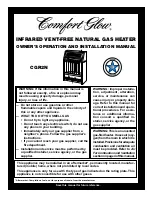
10
53D0501
18/24/30VL Unvented Gas Logs
COMBUSTION and VENTILATION AIR REQUIREMENTS
As do all gas-fired appliances, this appliance requires
fresh air (oxygen) for proper combustion and ventilation.
In some cases, but not all, normal air infiltration into a
building will supply a sufficient amount of fresh air for
proper combustion and ventilation. The number of gas-
fired appliances involved, the type of space being utilized,
and the construction tightness of the building involved
must all be considered when determining whether normal
air infiltration is sufficient or if additional fresh air will be
needed for proper combustion and ventilation of the gas-
fired appliances installed in a particular space.
Unconfined space and confined space are the terms
used to describe the space in which gas-fired appliances
may be installed. The National Fuel Gas Code, ANSI
Z223.1/NFPA 54 defines a confined space as a space
whose volume is less than 50 cubic feet per 1,000 BTU
per hour (4.8 m
3
per kW) of the aggregate input rating of
all gas-fired appliances installed in that space. Rooms
communicating directly with the space in which the
appliances are installed, through openings not furnished
with doors, are considered a part of the "to be defined"
space. For example, three rooms in a house are adjoining
with interconnecting passageways but no doors; each room has an 8-foot ceiling. One room
is 16 x 12 feet, one is 12 x 12 feet and one is 10 x 14 feet. The total volume of the three
rooms is 3,808 cubic feet; (8x16x12) plus (8x12x12) plus (8x10x14) equals 3,808 cubic
feet. To be considered an unconfined space, the total maximum aggregate input rating
of all gas-fired appliances installed in the 3,808 cubic feet space must not exceed 76,160
BTU per hour; (3,808 divided by 50) x 1,000 equals 76,160 BTU per hour.
Normal air infiltration into an unconfined space will be adequate to supply the necessary
fresh air for proper combustion and ventilation if the building is not constructed unusually
tight. However, if the building is of unusually tight construction, additional fresh air from
outside will be required for proper combustion and ventilation of the gas-fired appliances
installed in the unconfined space. Unusually tight construction is defined as constructions
where:
a) walls and ceilings exposed to the outside atmosphere have a continuous water vapor
retarder with a rating of 1 perm (6 x 10
11
kg per pa-sec-m
2
) or less with openings
gasketed or sealed;
b) weather stripping has been added on openable windows and doors, and
c) caulking or sealants are applied to areas such as joints around window and door frames,
between sole plates and floors, between wall-ceiling joints, between wall panels, at
penetrations for plumbing, electrical, and gas lines, and at other openings.
WARNING
If the area in which this appliance may be
operated is smaller than that defined as an
unconfined space or if the building is of unusually
tight construction, provide adequate combustion
and ventilation air by one of the methods
described in the National Fuel Gas code, ANSI
Z223.1/NFPA 54, Section 5.3 or applicable local
codes. This appliance shall not be installed in a
confined space or unusually tight construction
unless provisions are provided for adequate
combustion and ventilation air.
CAUTION
Because water is a product of fuel gas combustion,
all gas-fired appliances will produce some water
vapor (humidity) when fired. The water vapor
may collect on windows and walls, especially in
buildings constructed unusually tight. Providing
additional fresh air will reduce the amount of
water vapor which collects on the windows and
walls.











































